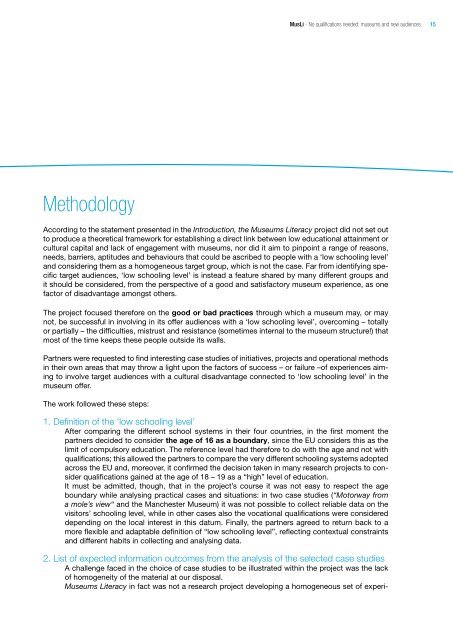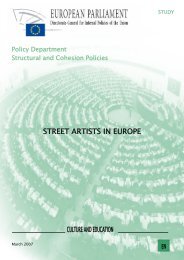MusLi (Museums Literacy) - Fondazione Fitzcarraldo
MusLi (Museums Literacy) - Fondazione Fitzcarraldo
MusLi (Museums Literacy) - Fondazione Fitzcarraldo
Create successful ePaper yourself
Turn your PDF publications into a flip-book with our unique Google optimized e-Paper software.
Methodology<br />
<strong>MusLi</strong> - No qualifications needed: museums and new audiences<br />
According to the statement presented in the Introduction, the <strong>Museums</strong> <strong>Literacy</strong> project did not set out<br />
to produce a theoretical framework for establishing a direct link between low educational attainment or<br />
cultural capital and lack of engagement with museums, nor did it aim to pinpoint a range of reasons,<br />
needs, barriers, aptitudes and behaviours that could be ascribed to people with a ‘low schooling level’<br />
and considering them as a homogeneous target group, which is not the case. Far from identifying specific<br />
target audiences, ‘low schooling level’ is instead a feature shared by many different groups and<br />
it should be considered, from the perspective of a good and satisfactory museum experience, as one<br />
factor of disadvantage amongst others.<br />
The project focused therefore on the good or bad practices through which a museum may, or may<br />
not, be successful in involving in its offer audiences with a ‘low schooling level’, overcoming – totally<br />
or partially – the difficulties, mistrust and resistance (sometimes internal to the museum structure!) that<br />
most of the time keeps these people outside its walls.<br />
Partners were requested to find interesting case studies of initiatives, projects and operational methods<br />
in their own areas that may throw a light upon the factors of success – or failure –of experiences aiming<br />
to involve target audiences with a cultural disadvantage connected to ‘low schooling level’ in the<br />
museum offer.<br />
The work followed these steps:<br />
1. Definition of the ‘low schooling level’<br />
After comparing the different school systems in their four countries, in the first moment the<br />
partners decided to consider the age of 16 as a boundary, since the EU considers this as the<br />
limit of compulsory education. The reference level had therefore to do with the age and not with<br />
qualifications; this allowed the partners to compare the very different schooling systems adopted<br />
across the EU and, moreover, it confirmed the decision taken in many research projects to consider<br />
qualifications gained at the age of 18 – 19 as a “high” level of education.<br />
It must be admitted, though, that in the project’s course it was not easy to respect the age<br />
boundary while analysing practical cases and situations: in two case studies (“Motorway from<br />
a mole’s view“ and the Manchester Museum) it was not possible to collect reliable data on the<br />
visitors’ schooling level, while in other cases also the vocational qualifications were considered<br />
depending on the local interest in this datum. Finally, the partners agreed to return back to a<br />
more flexible and adaptable definition of “low schooling level”, reflecting contextual constraints<br />
and different habits in collecting and analysing data.<br />
2. List of expected information outcomes from the analysis of the selected case studies<br />
A challenge faced in the choice of case studies to be illustrated within the project was the lack<br />
of homogeneity of the material at our disposal.<br />
<strong>Museums</strong> <strong>Literacy</strong> in fact was not a research project developing a homogeneous set of experi-<br />
15






